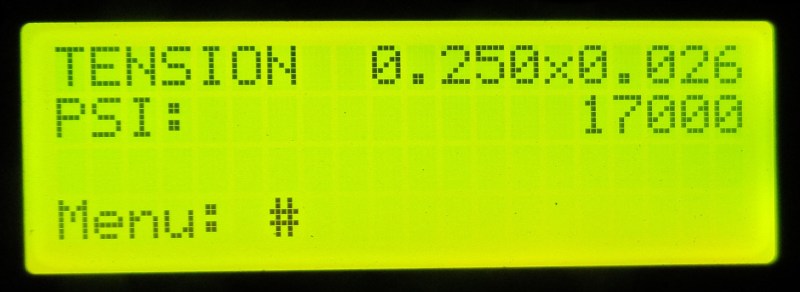No matter what material you’re cutting, getting the blade tension right is one of the keys to quality cuts on the bandsaw. Unfortunately, most bandsaws come with only a rudimentary tension gauge, and while there are plenty of tricks for measuring blade tension indirectly, nothing beats a digital blade tension gauge for repeatable results.
Despite being an aftermarket accessory for his beefy Hitachi CB-75F bandsaw, [Stephen B. Kirby]’s Pi-based tension guide looks like an OEM product. Housed in a sturdy case and sporting a sealed membrane keypad and four-line LCD display, the interface electronics are pretty straightforward. The tricky bit is sensing the amount of tension on the bandsaw blade. For that task, [Stephen] mounted a load cell in place of the original tensioning spring. A few adapters helped that job, and with a little calibration, the gauge is capable of displaying the tension by measuring the force over the cross-sectional area of the current blade.
We really like it when electronics can bring a new level of precision to old-school hardware, whether it’s a simple DRO for a manual lathe or a more accomplished build like [Stephen]’s. Sometimes adding new silicon can make old iron a little easier to use.
















Nice project, not easy on a beast of that size. i had years of struggling getting a bandsaw cutting straight, usually involved buying another one! I tried the method suggested in the bandsaw clinic by Alex Snodgrass vid. Amazing difference.. no problem resawing 1mm sheets. it was all in the setup. The first part of his vid is an education from a master. the second part is just showing off. :)
https://www.youtube.com/watch?v=wGbZqWac0jU
Thanks for posting that. Quite good. The reindeer was a surprise bonus.
Thanks from me too. My shop and my neighbors will benefit from this man’s teaching.
Ultrasound can also work as a non-contact sensing solution.
Isn’t raspberrypi way overkill for a simple input, a little math, and an lcd?
raspi is the new arduino
it seems like that… but with the disadvantage of not being able to use it directly after switching it on (booting procedure) and being capable of switching it off when you want to (shutdown procedure).
So this complete overkill is actually an ode to how far technology has come… the funny thing is that it could easily be done it with passive components only, a load cell in a bridge configuration plus a simple sensitive analog gauge and that’s it. But then it would have no “bells and whistles” would it?
I’m getting old…
lol, I’m 32 and I feel ancient these days. I’m routinely laughed at and called archaic by students for spending a week designing a PCB and firmware, instead of using an Arduino, libraries and a shield.
Yes I know what your mean. Although they seem to be faster at first, they learned nothing from the project. So when troubles arrive (in the form of a bug in the library they used) then they can’t fix it because the do not know the details of it really works. So when troubles arrive, you’ll be the one who is laughing.
PI overkill? Ive got a doall vertical bandsaw for metal cutting, and a smaller ryobi one for wood, and I’ve never even felt the need to use a tension gauge! I just wind them up till it makes the right sort of spang noise when twanged and cut straight.
I’ve never actually had to replace a blade thats broke…
Absolutely. A simple lookup table with interpolation for the load cell and the menu code that I wrote for graphical lcd’s last week would have easily sufficed on a arduino nano.
An ammeter or a voltmeter could have done the job, plus it would blend with the equipment because its analog.
I tighten my bandsaw by pitch and have for 20 years. I don’t have a number for the tension, though I could calculate one if I cared. Of course, I’m always using the same blade. A different blade would mean a different pitch.